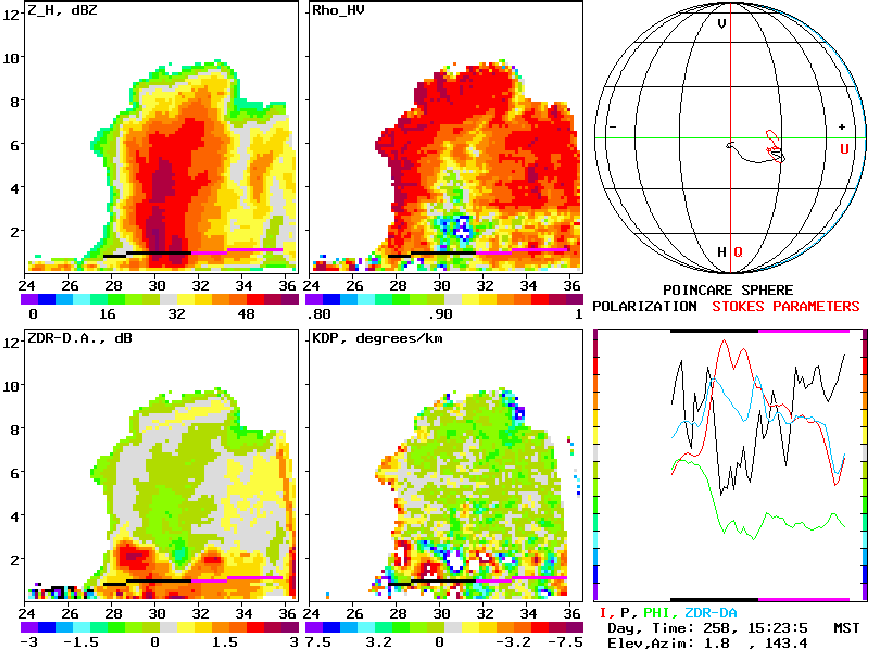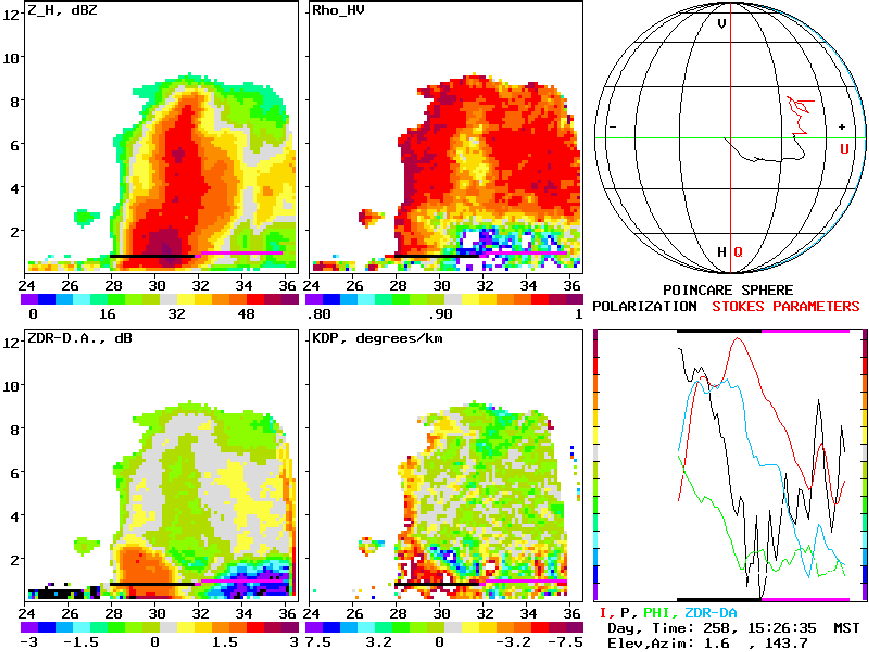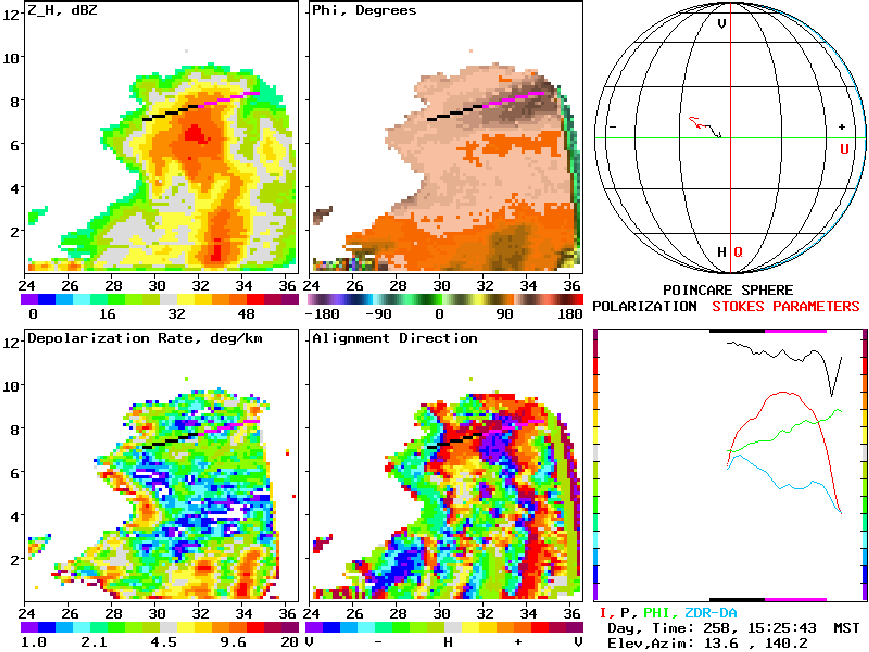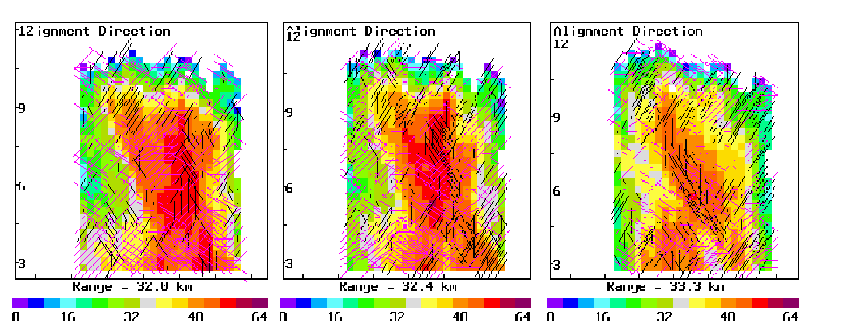 |
Balakrishnan, N., and D.S. Zrnic, 1990a: Use of polarization to Characterize precipitation and discriminate large hail. J. Atmos. Sci., 47, 1525-1540.
Balakrishnan, N., and D.S. Zrnic, 1990b: Estimation of rain and hail rates in mixed-phase precipitation. J. Atmos. Sci., 47, 565-583. Barge, B., 1972: Hail detection with a polarization-diversity radar, Stormy Weather Group Sci. Rep. MW-71, McGill University.
Bebbington, D., R. McGuinness, and A. Holt, 1987: Correction of Propagation effects in S-Band circular polarization-diversity radars. IEE Proc., 134, 431-437.
Born, M., and E. Wolf, 1975: Principles of Optics. Pergamon Press, 808 pp.
Bringi, V., V. Chandrasekar, N. Balakrishnan, and D. Zrnic, 1990: An examination of propagation effects in rainfall on radar measurements at microwave frequencies, J. Atmos. Oceanic Technol., 7, 829-840.
Bringi, V., and A. Hendry, 1990: Technology of Polarization Diversity Radars for Meteorology. Radar Meteorology, David Atlas, Ed., Amer. Meteor. Soc., 153-190.
Brunkow, D., P. Kennedy, S. Rutledge, V. Bringi, and V. Chandrasekar, 1997: CSU-Chill radar status and comparison of available operating modes. Preprints, 28th Conf. Radar Meteorology, Austin, Amer. Meteor. Soc., 43-44.
Caylor, I., and V. Chandrasekar, 1996: Time-Varying Ice Crystal Orientation in Thunderstorms Observed with Multiparameter Radar. Geosci. Remote Sens., 34, 847-858.
Chen, T., 1994: Radar Detection of Electrically Aligned Particles in Thunderstorms. PhD. Thesis, New Mexico Institute of Mining and Technology, 198 pp.
Doviak, R., and D. Zrnic, 1993: Doppler Radar and Weather Observations. Academic Press, 562 pp.
Dye, J., J. Jones, A. Weinheimer, and W. Winn, 1988: Observations within two regions of charge during initial thunderstorm electrification. Q. J. R. Meteorol. Soc., 114, 1271-1290.
Hendry, A., and A. Antar, 1982: Radar observations of polarization characteristics and lightning-induced realignment of atmospheric ice crystals. Radio Sci., 17, 1243-1250.
Hendry, A., and A. Antar, 1984: The variation of measured cross-polarized echo intensity in rain with direction of polarization and its implication for canting angle distributions, Preprints, 22nd Radar Meteorol. Conf., Zurich, 382-386.
Hendry, A., and G. McCormick, 1976: Radar observations of alignment of precipitation particles by electrostatic fields in thunderstorms. J. Geophys. Res., 81, 5353-5357.
Holt, A., and J. Tan, 1992: Separation of differential propagation phase and differential backscatter phase in polarization diversity radar. Electronics Letters, 28, 943-944.
Hooker, S., J. Brown, and A. Kirwan Jr., 1995: Detecting ``Dipole Ring'' Separatrices with Zebra Palettes. Geosci. Remote Sens., 33, 1306-1312.
Hubbert, J., V. Chandrasekar, V. Bringi, and P. Meischner, 1993: Processing and Interpretation of Coherent Dual-Polarized Radar Measurements. J. Atmos. Oceanic Technol., 10, 155-164.
Hubbert, J., V. Bringi, L. Carey, and S. Bolen, 1998: CSU-CHILL polarimetric radar measurements from a severe hail storm in eastern Colorado. J. Appl. Meteorol., 37, 749-775.
Humphries, R., 1974: Depolarization effects at 3 GHz due to precipitation, Stormy Weather Group Sci. Rep. MW-82, McGill University.
Jameson, A., and J. Davé, 1988: An interpretation of circular polarization measurements affected by propagation differential phase shift. J. Atmos. Oceanic Technol., 5, 405-415.
Kostinski, A., 1994: Fluctuations of differential phase and radar measurements of precipitation. J. Appl. Meteor., 33, 1176-1181.
Krehbiel, P., The electrical structure of thunderstorms, in The Earth's Electrical Environment, Nat'l. Academy Press, Washington, D.C., pp. 90-113, 1986.
Krehbiel, P., T. Chen, S. McCrary, W. Rison, G. Gray, and M. Brook, 1996: The use of dual channel circular-polarization radar observations for remotely sensing storm electrification. Meteor. Atmos. Phys., 58, 65-82.
Krehbiel, P., and R. Scott, 1999: A geometrical approach to characterizing and interpreting dual-polarization radar meteorological observations, to be submitted to Geosci. Remote Sens..
McCormick, C., and A. Hendry, 1985: Optimal Polarizations for Partially Polarized Backscatter. IEEE Trans. Ant. Prop., AP-33, 33-39.
McCormick, C., 1979: Relationship of differential reflectivity to correlation in dual-polarization radar. Electron. Lett., 15, 265-266.
McCormick, C., and A. Hendry, 1979: Radar Measurement of Precipitation-Related Depolarization in Thunderstorms. IEEE Trans. Geosci. Elec., GE-17, 142-150.
McCormick, C., and A. Hendry, 1975: Principles for the Radar Determination of the Polarization Properties of Precipitation. Radio Sci., 10, 421-434.
Metcalf, J., 1995: Radar observations of changing orientations of hydrometeors 34, 757-772.
Metcalf, J., 1997: Temporal and Spatial Variations of Hydrometeor orientations in thunderstorms. J. Atmos. Sci., 36, 315-321.
Mott, H., 1986: Polarization in Antennas and Radar. John Wiley and Sons, 297 pp.
Oguchi, T., 1983: Electromagnetic Wave Propagation and Scattering in Rain and Other Hydrometeors. Proc. IEEE, 71, 1029-1078.
Rison, W., G. Gray, P. Krehbiel, and T. Chen, 1993: A compact real-time radar signal processing and display system. Preprints, 26th Conf. Radar Meteorology, Boston, Amer. Meteor. Soc., 258-259.
Zrnic, D.S., and A.V. Ryzhkov, 1999: Polarimetry for weather surveillance radars Bull. Amer. Meteorol. Soc., 80, 389-406.
Sachidananda, M. and D.S. Zrnic, 1985: ZDR measurement considerations for a fast scan capability radar. Radio Sci., 20, 907-922.
Santalla, V., Y. Antar, and A. Pino, 1999: Polarimetric radar covariance matrix algorithms and applications to meteorological radar data. Geosci. Remote Sens., 37, 1128-1137.
Scott, R., 1999: Dual-Polarization Radar Meteorology: A Geometrical Approach. PhD. Thesis, New Mexico Institute of Mining and Technology, 129 pp.
Stolzenburg, M., W.D. Rust, B.F. Smull, and T.C. Marshall, 1998a: Electrical structure in thunderstorm convective regions, 1: Mesoscale convective systems J. Geophys. Rsch., 103, 14059-14078.
Stolzenburg, M., W.D. Rust, and T.C. Marshall, 1998b: Electrical structure in thunderstorm convective regions, 2: Isolated storms J. Geophys. Rsch., 103, 14079-14096.
Tan, J., A. Holt, A. Hendry, and D. Bebbington, 1991: Extracting rainfall rates from X-band CDR radar data by using differential propagation phase shift, J. Atmos. Oceanic Technol., 8, 790-791.
Torlaschi, E., and A. Holt, 1993: Separation of Propagation Effects in Rain for Circular Polarization Diversity S-Band Radars. J. Atmos. Oceanic Technol., 10, 465-477.
Torlaschi, E., and A. Holt, 1998: A comparison of different polarization schemes for the radar sensing of precipitation. Radio Sci., 33, 1335-1352.
Vivekanandan, J., R. Raghavan, and V. Bringi, 1993: Polarimetric Radar Modeling of Mixtures of Precipitation Particles. Geosci. Remote Sens., 31, 1017-1030.
Vivekanandan J., D.S. Zrnic, S.M. Ellis, R. Oye, A.V. Ryzhkov, J. Straka, 1999: Cloud microphysics retrieval using S-band dual-polarization radar measurements, Bull. Amer. Meteorol. Soc., 80, 381-388.
 |
 |
 |
 |
 |